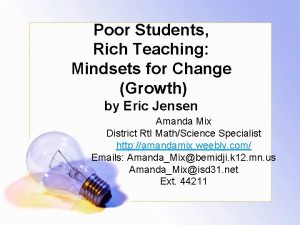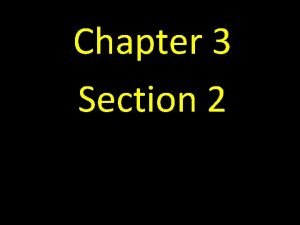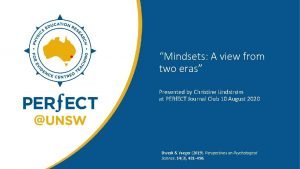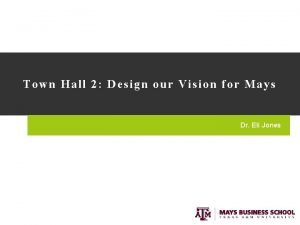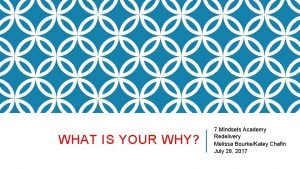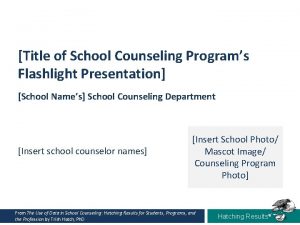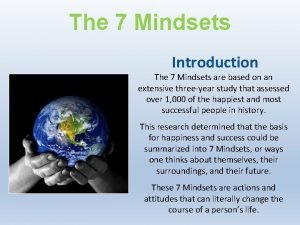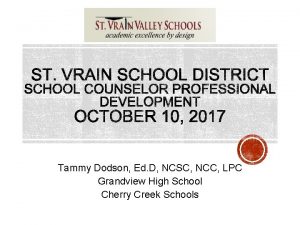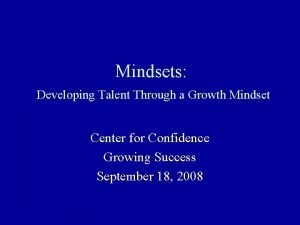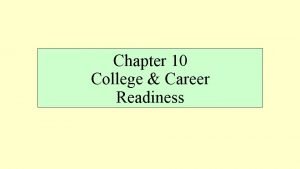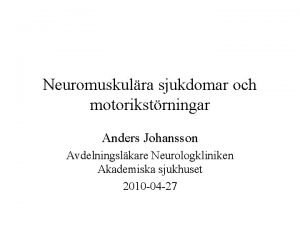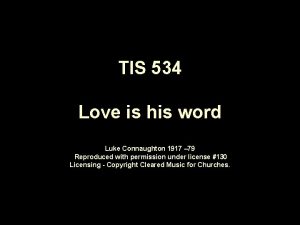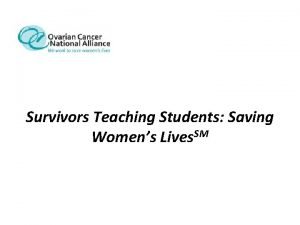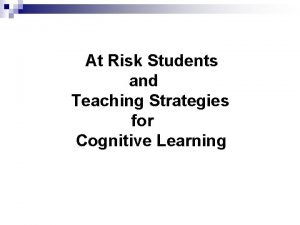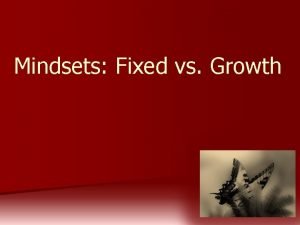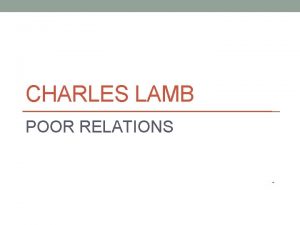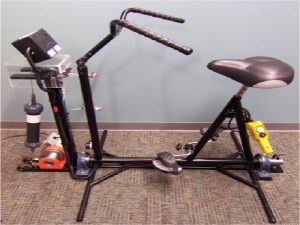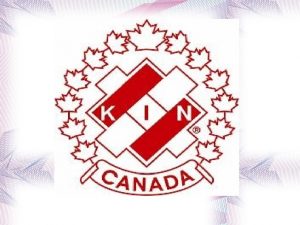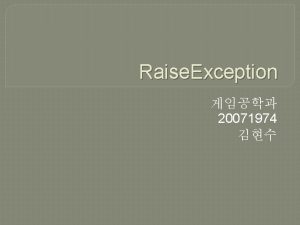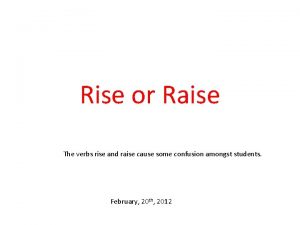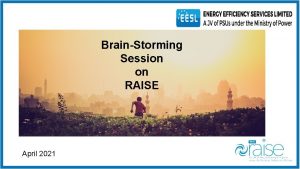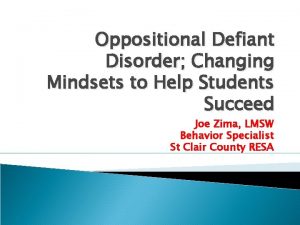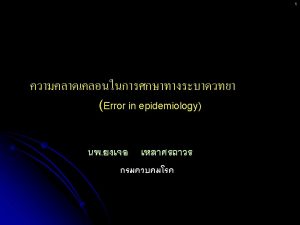Poor Students Richer Teaching Mindsets that Raise Student






























- Slides: 30

Poor Students, Richer Teaching: Mindsets that Raise Student Achievement by Eric Jensen Amanda Mix District Rt. I Math/Science Specialist http: //amandamix. weebly. com/ Emails: Amanda_Mix@bemidji. k 12. mn. us Amanda_Mix@isd 31. net Ext. 44211

Introduction: • “To change students lives, you will have to change before any worthwhile change shows up in your students” (Poor Students, Rich Teaching = referenced as Book 1). • “Richer means full, bountiful, better than ever” (pg. 1). • The Three Mindsets: * The Positivity Mindset (Chpts. 2 -7) * The Enrichment Mindset (Chpts. 8 -13) * The Graduation Mindset (Chpts. 14 -17)

The Three Mindsets: • The Positivity Mindset: • “I am an optimistic and grateful ally who helps students build a successful narrative of their future. ” • The Enrichment Mindset: • “I know brains can change. I can grow and change myself first. Then, I can build powerful cognitive skills in my students. ” • The Graduation: • “Focus on what matters. Be an ally to help students graduate college and career ready. ” Be an ALLY. There is no us (teachers) and them (students). The pronoun is WE (a team).

The New Normal (Chapter 1) • “Our jobs have changed. ” You’re right. “The world has changed” (pg. 5, Book 1). • Poverty is far more prevalent and the effects are accelerating. 76% of Americans are living paycheck to paycheck. • The average four-year graduation rate in the U. S. is 53%. • Disappearing middle class. • Technology has replaced people for many jobs.

What More Poverty Means to You (Book 1) • Stress: When the amygdala responds at a normal rate(homeostasis) *Hypervigilance (triggers safety alarm to often): anxiety, PTSD *Hyporesponsiveness (not enough): helplessness, depression • Cognitive Gaps: language (25 vs. 40 million), memory, cognitive control • Less Emotional Support: No one teaches them how to respond (social skills). “Students care more about whether their teachers care than what their teachers know” (pg. 11).

What More Poverty Means to You • Every day at work, fresh empathy is a good place to start. • Children of poverty differ in four experiences: *Health issues (poor diet, exposure to toxins) *Chronic stress *Weaker cognitive skills (vocab. , rdg. , work. memory) *Impaired socioemotional relationships “Teachers who do not know what these behaviors really are may inappropriately judge a student as lazy, unwilling to follow directions, a poor listener, low achieving, and/or antisocial” (pg. 7).

Secrets of the Positivity Mindset (Chapter 2) • Empathy NOT Sympathy • The Positivity Mindset: • “I am an optimistic and grateful ally who helps students build a successful narrative of their future” (pg. 15). • The effects of socioeconomic status on positive to negative comments (1: 2, 2: 1, 6: 1) • High Positivity vs. Low Positivity (pg. 17) • The impact of positivity on the brain: dopamine, serotonin, noradrenaline (pg. 20)

Secrets of the Positivity Mindset (Chapter 2 Continued) • Four Strategies to Promote a Positivity Mindset: • • Boost optimism and hope (Chapter 3) Build positive attitudes (Chapter 4) Foster control, choice, and relevancy (Chapter 5) Change the emotional set point (Chapter 6) “Positive affect in school contributes to more kindness, better health, increased participation, fewer absences, and greater achievement” (pg. 21).

Boost Optimism and Hope (Chapter 3) • Model optimism daily. • Teaching perspective, using word nutrients, and overcoming setbacks. • Build hope daily. • Giving daily affirmations, teaching goal setting, encouraging dreams, displaying daily progress, sharing success stories, finding a cause, assigning real-world jobs, and including affirmations of hope. • Build students’ self-concept and effort levels. • Using a power minute, listening without judgment, affirming student strengths with a connection, and creating a classroom directory. • Develop hope relentlessly. • Supporting dreams, and building strong relationships

Build Positive Attitudes: Attitude is Gratitude! (Chapter 4) • Gratitude building • Keep it personal, start with a goal, favor depth over breadth, use a take-away-the-goodness strategy, reflect on the good things weekly, and keep the gratitude process fresh. • Service work (public work) and acts of kindness • Help students become net givers instead of net takers (local/national news, animal shelters, parks, senior/nursing homes, agencies, military families) • The Magic Three: I respect, I agree with, I appreciate • Personal responsibility and self-regulation • Running your own brain, learning from real-world examples, reframing to stay positive, handling the negatives constructively, and choosing your battles.

Foster Control, Choice, and Relevancy (Chapter 5) • The invisible teaching velocity-reaching students emotionally and personally. • “When students feel stress, they crave control… When control increases, a sense of personal efficacy also increases” (pgs. 45 -46). • Choice vs. Compliance • Granting students choices and control can enhance long-term memory. (Stop using concrete rewards. ) • Sell the choice, and honor student choices. • Choices: Quick Writes, suggestions box, self-assessments, class jobs, and social activities and projects (pg. 49) • Reduces stress

Change the Emotional Set Point (Chapter 6) • E. S. Point = A person’s most common emotional state • Classroom behaviors that connect with emotions include: learning, regulation, coping, and consistency. • Service work (public work) and acts of kindness • Help students become net givers instead of net takers. (local news, shelters, parks, military families) • The Magic Three: I respect, I agree with, I appreciate • Personal responsibility and self-regulation • Running your own brain, learning real-world examples, reframing to stay positive, handling negatives constructively, and choosing your battles

Change the Emotional Set Point (Chapter 6 Continued) • Three Types of Happiness (pg. 55): • Spontaneous: In the moment (surprise, smile, sunset) • Hedonic: Pursued pleasure (TV, foods, shopping, hunting) • Eudaimonic: Long-Term (new skill, relevant, project) • How to Change Students’ Emotional Set Points • • Use meaningful projects (project-based learning) Focus on the end product (gutsy goals) Tie feedback to quality Reinforce what is working “The eudaimonic state happiness is an everyday, moodgenerating state that works magic in your school…This cycles positive energy and hope back to the teachers, who in term feel affirmed and rewarded” (pg. 58). It is invisible, yet powerful.

Lock in the Positivity Mindset (Chapter 7) • Change the Narrative, Change your Teaching • The narrative is the explanatory description of what is happening in your class (you and your students’ lives). • You, as the teacher, are leading students to build a positive narrative. • Reflection and Decision • Self-reflect first. • “You always have a choice-even when you think you don’t” (pg. 61). • Developing a Positivity Mindset Includes: • Creating a new narrative, choosing a positivity strategy to develop with urgency, and creating a support process to ensure successful implementation

Secrets of the Enrichment Mindset (Chapter 8) • The Enrichment Mindset: • “I know brains can change. I can grow and change myself first. Then, I can build powerful cognitive skills in my students” (pg. 67). • Teachers/students, have control over their brains, effort, strategies, and attitude, and can improve ALL of these. • The brain is malleable, not fixed. • We CAN teach the Enrichment Mindset. • Language, memory, and cognitive control are lower in students affected by poverty. • Four Strategies to Help Enrich your Students: • Manage the cognitive load, develop better thinking skills, enhance study skills and vocabulary, and build better memory

Manage the Cognitive Load (Chapter 9) • Cognitive Load: • The quantity of thoughts one has loaded in his or her brain at any given time. Unless addressed, you will perceive students from poverty as slow learners (brain interference = slow Internet speed). • Tools to Reduce Cognitive Load Issues: • Help students care more, digest better, and/or remember longer. Make the classroom emotionally safe and physically safe, chunk material, hit the pause button, stretch the content, and use spaced relevance. • Tools to Strengthen Retrieval • Use visual organizers (cartoon, mind map, flow chart, etc. ), and gesture the content (90% retention).

Develop Better Thinking Skills (Chapter 10) • Critical thinking means having effectiveness, novelty, and self direction. • Critical thinking is only effective when students avoid common mistake biases: seeing only one side of an issue, discounting new evidence that runs counter to their ideas, failing to use basic rules of logic, or failing to look for evidence. • Tools for Optimal Reasoning Include (pg. 86): • Seek, apply standards, interpret and define the true problem, analyze, compare and contrast solutions, check, use inductive and deductive reasoning, make predictions and inferences, translate, explain, and take action.

Develop Better Thinking Skills (Chapter 10 Continued) • Use your own subject matter to foster the skills that apply to your class. • • • Teach the language of thinking Seek out information to solve a problem Ask the right questions Form effective arguments Deconstructs Use argument mapping Use student verbalization Use a reasoning questioning schema Use powerful questions Support top-flight thinking skills (claim, support, question, “What else is true or not? ”)

Enhance Study Skills and Vocabulary (Chapter 11) • Research of Study Skills is Complicated: • There is no research agreement regarding strategies or tactics, metacognitive interventions can increase the effectiveness of study tools, and cognitive skills usage also has an affective side (motivation/persistence). • High-impact Study Skills (pg. 92) • Relational Study Aids • Vocabulary Skill Building: • Role-model, use big words, use direct vocabulary instruction (demonstration, verbal, nonverbal, engagement, and reciprocal teaching, use of games) • Vocabulary instruction has a 2. 27 effect size.

Build Better Memory (Chapter 12) • Working memory is a greater predictor of student than even a student’s IQ. • Build Long-Term Memory: • Timing, semantic, body, and feelings • Mnemonics, acronyms, abbreviations • Emotions, music • Build Short-Term and Working Memory (pg. 109) • Identify: Name games, vocabulary builders, number manipulation, memory quizzes • Repeat: Simon Says, clapping, repeat after me activities • Songs: Cadence songs, call-response songs • Add Ons: content add-on review builders, number strings, word boxes or file folders

Lock in the Enrichment Mindset (Chapter 13) • “Since the brain can change, there are no low students only students in low environments” (pg. 119). • It does not claim that everyone can become an Einstein; merely that everyone has potential for growth. • Everything can be enriched: • Social skills, punctuality, respect, vocabulary, and cognitive skills • “All students really can learn, as long as you are an ally” (pg. 119). • Think to yourself, “What else can I enrich? ” “All meaningful and lasting change starts with a mirror” (pg. 118).

Secrets of the Graduation Mindset (Chapter 14) • “High poverty schools can and do succeed. It is often the staff’s mindset that is broken” (pg. 123). • Every day, remind yourself, “Our students need every minute I can invest in each and every day. ” Stop listening to the negativity. • The Graduation Mindset” • “Focus on what matters. Be an ally to help students graduate college and career ready” (pg. 124). • What do high performing schools do? (pgs. 126 -127) • Strategies to help your students prepare for graduation: • Support alternative solutions • Prepare for college and careers

Support Alternative Solutions (Chapter 15) • The alternatives that help students soar: • The arts (musical, performing, kinetic, and visual arts) • Physical activity • 3 -5 days a week for 30 -90 minutes in the arts promotes: • Effort, processing sills, attentional skills, memory capacity, and sequencing skills • Wire the brain for academic success-motor skills (pg. 133) • Why physical activity? It fosters new brain cells. • Vocabulary learning is 20% faster after intense physical exercise, it boosts dopamine, raises the production of noradrenaline, and reduces classroom discipline issues. • It provides capture-real control to lower stress = success.

Prepare for College and Careers, and Lock it In (Chapters 16 and 17) • The Power of Career and Technical Education • Increase exposure, link behaviors and outcomes, link the content, assume the attribution, boost system knowledge, offer supplemental programs. • When this happens, students WANT to be at school. • Teachers prove to students, “They care about my future. ” • It is highly relevant, and students understood their long term goals (they had things to do). • College and Career Ready Resources (pg. 143): • “We will do whatever is necessary to help students graduate. ” • Really we are saying, “We will do whatever is necessary to help students see their future as a worthwhile goal. ”

Rich Lesson Planning (Appendix A) • “Rich lesson planning is critical. When your lessons are rich, they include HOW you teach, not just WHAT you teach” (pg. 149). • Collaboration, pre-assessment, relevance and buy-in, attribution (maximum value out of every moment) • Before class, during class, action steps • Matching big goals with our lesson plans (pg. 150): • Look at the data, turn data into meaning, and discuss concerns • Break down the meaning into actionable work, make learning goals, and turn the work into lesson plans • Use quality feedback standards for all, establish implementation goals, use frequent feedback, and get feedback on instruction (watching your lesson)

Engage for Setup and Buy-In (Book 1) • Setup vs. Buy-In • Setups are attention-getters (creates curiosity, hooks, incites excitement) • Buy-ins say to the learner “This is worth learning, pay attention, and save it!” (pg. 162) • Asking Questions for Buy-In: • Great questions can change class climate and even student lives if done well (effect size of 0. 81). • Questions should involve: discovery, essential questions, summarizing the content, elaborative questions, and evidence -gathering questions (pg. 165).

Running Your Own Brain (Appendix B) • “Your brain can change in an instant” (pg. 163). • Great teachers have all three working in their favor: • The meaning making narrative system (ongoing stories, personality and character) on pg. 164 • The stress-response system (grit and persistence, stress tolerance) on pg. 166 • The reward system (good feelings for you, importance, focus on daily and long term events) on pg. 170 • Each system includes teacher implication and action steps. “When you do embrace the mindsets and action steps…and when you do unleash your new narratives, mindsets, and strategies, you can expect a richer life beyond anything you’ve ever dreamed of. That’s a promise” (pg. 172).

Other Info. From Book 1: Four of the Most Effective Achievement Boosters of All Time • Set gutsy goals (Chapter 9). Effect size 1. 44 • Set goals “crazy high”, quantify them, and keep them simple. Then, set micro goals and give feedback on the way to reaching the gutsy goals. • Have the right attitude (Chapter 10). Effect size 1. 42 • Model the achievement mindset, model high-achievement thinking, sow the seeds of success, and attribute connections. • Give fabulous feedback (Chapter 11). Effect size 0. 65 • More positives than negatives (3: 1), and be specific enough to focus on key things students can change. • Persist with grit (Chapter 12). Effect size 0. 8 -1. 0 • The tenacity to pursue a longer term goal in the face of obstacles…for something worthwhile.

Four Crucial Mindsets (Book 1): • The Relational Mindset: • “We are all connected in this life together. Always connect first as a person (and an ally) and then as a teacher second. ” • The Achievement Mindset: • “I can build student effort, motivation, and attitudes to succeed. They are all teachable skills. ” • The Rich Classroom Climate Mindset: • “I focus on what students need to succeed and build it into the learning and social environment every day. ” • The Engagement Mindset: • “I can and will engage with purpose every student, every nine minutes or less, guaranteed. ”

Questions to Always Ask Yourself (Book 1): • Answering Final Questions to Elicit Change (pgs. 178, 179) • Questions to Ask at the End of a Lesson or Day of Teaching: • Did I do my best to foster optimism/gratitude today? • Did I do my best to make this work relevant to both me and my students? • Did I do my best to foster stronger personal relationships? • Did I do my best to fully engage and help others? • Did I do my best to grow personally and professionally today? Did I do my best?
 Relational mindset
Relational mindset How does welfare attempt to raise poor
How does welfare attempt to raise poor False growth mindset
False growth mindset Mays transformational leader mindsets
Mays transformational leader mindsets 7 mindsets academy
7 mindsets academy Asca mindsets and behaviors chart
Asca mindsets and behaviors chart 7 mindsets.com
7 mindsets.com Asca mindsets and behaviors
Asca mindsets and behaviors Developing talent through a growth mindset
Developing talent through a growth mindset Asca mindsets and behaviors
Asca mindsets and behaviors Esntv
Esntv The richer the poorer by dorothy west
The richer the poorer by dorothy west What is liquefaction in geography
What is liquefaction in geography Oromandibulär dystoni
Oromandibulär dystoni Richer interaction in hci
Richer interaction in hci Injustice anywhere is a threat to justice everywhere essay
Injustice anywhere is a threat to justice everywhere essay Luke connaughton
Luke connaughton Hatshepsut wanted to make egypt richer through
Hatshepsut wanted to make egypt richer through Thơ thất ngôn tứ tuyệt đường luật
Thơ thất ngôn tứ tuyệt đường luật Tôn thất thuyết là ai
Tôn thất thuyết là ai Phân độ lown ngoại tâm thu
Phân độ lown ngoại tâm thu Walmart thất bại ở nhật
Walmart thất bại ở nhật Gây tê cơ vuông thắt lưng
Gây tê cơ vuông thắt lưng Block xoang nhĩ ecg
Block xoang nhĩ ecg Tìm vết của mặt phẳng
Tìm vết của mặt phẳng Sau thất bại ở hồ điển triệt
Sau thất bại ở hồ điển triệt Thơ thất ngôn tứ tuyệt đường luật
Thơ thất ngôn tứ tuyệt đường luật Hãy nói thật ít để làm được nhiều
Hãy nói thật ít để làm được nhiều Miguel morayta and jose rizal
Miguel morayta and jose rizal Survivors teaching students
Survivors teaching students Teaching at risk students
Teaching at risk students
